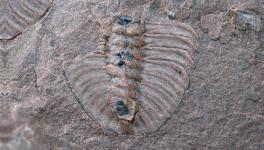What Is Revealed by Newly Discovered Fossil Deposits in China About Life 500 Million Years Ago

Image Courtesy: Fu et al.
It is known that around 500 million years ago, Earth had living organisms surviving in the oceans. However, it is still elusive how the living organisms and algae developed in the oceans. In this context, a newly discovered fossil deposit in Kunming area of China has brought some exciting news for the scientists. These fossil reserves may hold the key to understanding how these ancient organisms built the foundations for lives that thrive on land and sea in the present day.
The fossil deposits of Kunming are stunning in the sense that they possess a treasure of early vertebrates and other rare, soft-bodied organisms; more importantly 50% of them are in larval and juvenile stages of development. It is very rare to discover larval and juvenile fossils. The fossils have been dated back to the Cambrian period, about 500 million years ago. The fossils have provided 2,846 specimens so far and this deposit is the eldest and most diverse found till date. The findings were reported in Nature Ecology and Evolution recently.
Commenting on the discovery, Julien Kimming, the collections manager at the Earth and Mineral Sciences Museum, Penn State was quoted as saying, “It's just amazing to see all these juveniles in the fossil record. Juvenile fossils are something we hardly see, especially from soft-bodied invertebrates."
The team that collected the fossils at the research site was led by Xianfeng Yang, a paleobiologist at Yunnan University, China. Yang measured and photographed the fossil specimens along with Kimming. The fossil deposit is termed as Haiyan Lagerstatte.
The team of researchers have been able to identify 118 species which include 17 new species in the Lagerstatte. It is a sedimentary deposit of extraordinary fossils having exceptional preservation including soft tissues.
The species identified include the ancestors of modern day insects and the crustaceans which include worms, algae, sponges and some early vertebrates relative of jawless fish. The fossils are fascinating for scientists; they contain eggs and an abundance of rare juvenile fossils which still have intact appendages and also visibly clear internal soft tissues.
Sara Kimmig, an assistant research professor at the Earth and Environmental Systems Institute at Penn State commented, “The specimens are so well-preserved that they are revealing body parts never before seen. The site preserved details like 3D eyes, features that have never really been seen before, especially in such early deposits.”
The researchers believe that it would be possible to do CT scan on the 3D features and reconstruct the animals to accrue more and more information from the archaic species found in the fossils.
The Lagerstatte contained several layers of sediment where the fossils were found. Each of the layers represented a burial event. However, most of the species identified in the research are found in the lowest layer. Subsequent layers also contained diverse species but not to the extent that the lowest layer had.
Researchers also think that the intervals represented in the layers and the species found there represent booms and perils of the marine community in that time. Many of the species found in the lowest layer may have come to the area of the deep water of Kunming Gulf protecting themselves from the strong ocean currents. But, the oxygen levels might have changed in time or some extraordinary environmental events occurred which led the sediment flowing down a slope and thus bury everything in the path—the occurrence of a mass extinction.
On the other hand, the abundance of juvenile fossils is indicative that the Haiyan Lagerstatte was a Paleo nursery where species thrived due to the environment there, conducive for reproduction and providing protection from predators.
Highlighting this, Sara Kimmig said, “Could these worms and jellyfish and bugs have developed something as sophisticated as a paleo nursery to raise their young? Whatever the case may be, it's fascinating to be able to parallel this behaviour to that of modern animals.”
The fossils are like goldmines for scientists who are researching on how different species in the ancient period developed and what information they leave for the modern-day species. It will be possible for scientists now to use the fossil collection to further study how the archaic animals developed to full grown stage starting from the larval stage.
“We'll see how different body parts grew over time, which is something we currently do not know for most of these groups. And these fossils will give us more information on their relationships to modern animals. We will see if how these animals develop today is similar to how they developed 500 million years ago, or if something has changed throughout time,” added Julian Kimmig.
The information obtained from the fossils will provide insights on the relationship among animals, because similar developmental patterns can establish a link among species.
The fossils will also help scientists understand how various species behaved during the Cambrian period, about 500 million years ago, a period when the Earth was warmer than what it is today.
Get the latest reports & analysis with people's perspective on Protests, movements & deep analytical videos, discussions of the current affairs in your Telegram app. Subscribe to NewsClick's Telegram channel & get Real-Time updates on stories, as they get published on our website.
















